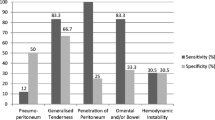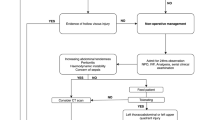Abstract
Purpose
Penetrating abdominal injuries caused by stabbing or firearms are rare in Germany, thus there is lack of descriptive studies. The management of hemodynamically stable patients is still under dispute. The aim of this study is to review and improve our management of penetrating abdominal injuries.
Methods
We retrospectively reviewed a 10-year period from the Trauma Registry of our level I trauma center. The data of all patients regarding demographics, clinical and outcome parameters were examined. Further, charts were reviewed for FAST and CT results and correlated with intraoperative findings.
Results
A total of 115 patients with penetrating abdominal trauma (87.8% men) were analyzed. In 69 patients, the injuries were caused by interpersonal violence and included 88 stab and 4 firearm wounds. 8 patients (6.9%) were in a state of shock at presentation. 52 patients (44.8%) suffered additional extraabdominal injuries. 38 patients were managed non-operatively, while almost two-thirds of all patients underwent surgical treatment. Hereof, 20 laparoscopies and 3 laparotomies were nontherapeutic. There were two missed injuries, but no patient experienced morbidity or mortality related to delay in treatment. 106 (92.2%) FAST and 91 (79.3%) CT scans were performed. Sensitivity and specificity of FAST were 59.4 and 94.2%, while those of CT were 93.2 and 85.1%, respectively.
Conclusion
In hemodynamically stable patients presenting with penetrating abdominal trauma, CT is indicated and the majority of injuries can be managed conservatively. If surgical treatment is required, diagnostic laparoscopy for stable patients is feasible to avoid nontherapeutic laparotomy.



Similar content being viewed by others
References
Bieler D, Franke A. Gunshot and stab wounds: combination of clinical and forensic medical data. Unfallchirurg. 2015;118:726. https://doi.org/10.1007/s00113-015-0037-4.
Inkinen J, Kirjasuo K, Gunn J, Kuttila K. Penetrating trauma; experience from Southwest Finland between 1997 and 2011, a retrospective descriptive study. Eur J Trauma Emerg Surg. 2015;41:429–33. https://doi.org/10.1007/s00068-014-0445-0.
Hoffmann C, Goudard Y, Falzone E, Leclerc T, Planchet M, Cazes N, et al. Management of penetrating abdominal trauma: what we need to know? Ann Fr Anesth Reanim. 2013;32:104–11. https://doi.org/10.1016/j.annfar.2012.12.006.
Bege T, Berdah SV, Brunet C. Stab wounds in emergency department. Presse Med. 2013;42:1572–8. https://doi.org/10.1016/j.lpm.2013.09.003.
Kristoffersen S, Normann S-A, Morild I, Lilleng PK, Heltne J-K. The hazard of sharp force injuries: factors influencing outcome. J Forensic Leg Med. 2016;37:71–7. https://doi.org/10.1016/j.jflm.2015.10.005.
Kauvar DS, Lefering R, Wade CE. Impact of hemorrhage on trauma outcome: an overview of epidemiology, clinical presentations, and therapeutic considerations. J Trauma. 2006;60:S3–11. https://doi.org/10.1097/01.ta.0000199961.02677.19.
Lutge E, Moodley N, Tefera A, Sartorius B, Hardcastle T, Clarke D. A hospital based surveillance system to assess the burden of trauma in KwaZulu-Natal Province South Africa. Injury. 2016;47:135–40. https://doi.org/10.1016/j.injury.2015.08.020.
Maxwell R, Trotter C, Verne J, Brown P, Gunnell D. Trends in admissions to hospital involving an assault using a knife or other sharp instrument, England, 1997–2005. J Public Health (Oxf). 2007;29:186–90. https://doi.org/10.1093/pubmed/fdm018.
Allen SR, Scantling DR, Delgado MK, Mancini J, Holena DN, Kim P, et al. Penetrating torso injuries in older adults: increased mortality likely due to “failure to rescue”. Eur J Trauma Emerg Surg. 2015;41:657–63. https://doi.org/10.1007/s00068-014-0491-7.
Shaftan GW. Indications for operation in abdominal trauma. Am J Surg. 1960;99:657–64.
Fabian TC, Croce MA, Stewart RM, Pritchard FE, Minard G, Kudsk KA. A prospective analysis of diagnostic laparoscopy in trauma. Ann Surg. 1993;217:557–64 (discussion 564–5).
Como JJ, Bokhari F, Chiu WC, Duane TM, Holevar MR, Tandoh MA, et al. Practice management guidelines for selective nonoperative management of penetrating abdominal trauma. J Trauma. 2010;68:721–33. https://doi.org/10.1097/TA.0b013e3181cf7d07.
Biffl WL, Moore EE. Management guidelines for penetrating abdominal trauma. Curr Opin Crit Care. 2010;16:609–17. https://doi.org/10.1097/MCC.0b013e32833f52d2.
Oreskovich MR, Carrico CJ. Stab wounds of the anterior abdomen. Analysis of a management plan using local wound exploration and quantitative peritoneal lavage. Ann Surg. 1983;198:411–9.
Cothren CC, Moore EE, Warren FA, Kashuk JL, Biffl WL, Johnson JL. Local wound exploration remains a valuable triage tool for the evaluation of anterior abdominal stab wounds. Am J Surg. 2009;198:223–6. https://doi.org/10.1016/j.amjsurg.2008.11.024.
Yildiz MK, Ozkan E, Odabasi HM, Eris C, Gunay E, Abuoglu HH, et al. Analysis of 120 patients with abdominal stab wound focusing on diagnostic role of fast. Int J Clin Exp Med. 2014;7:1386–90.
Rehm CG, Sherman R, Hinz TW. The role of CT scan in evaluation for laparotomy in patients with stab wounds of the abdomen. J Trauma. 1989;29:446–50.
Inaba K, Okoye OT, Rosenheck R, Melo N, Branco BC, Talving P, et al. Prospective evaluation of the role of computed tomography in the assessment of abdominal stab wounds. JAMA Surg. 2013;148:810–6. https://doi.org/10.1001/jamasurg.2013.2521.
Chestovich PJ, Browder TD, Morrissey SL, Fraser DR, Ingalls NK, Fildes JJ. Minimally invasive is maximally effective: Diagnostic and therapeutic laparoscopy for penetrating abdominal injuries. J Trauma Acute Care Surg. 2015;78:1076–83. https://doi.org/10.1097/TA.0000000000000655 (discussion 1083–5).
O’Malley E, Boyle E, O’Callaghan A, Coffey JC, Walsh SR. Role of laparoscopy in penetrating abdominal trauma: a systematic review. World J Surg. 2013;37:113–22. https://doi.org/10.1007/s00268-012-1790-y.
Lin H-F, Wu J-M, Tu C-C, Chen H-A, Shih H-C. Value of diagnostic and therapeutic laparoscopy for abdominal stab wounds. World J Surg. 2010;34:1653–62. https://doi.org/10.1007/s00268-010-0485-5.
Biffl WL, Kaups KL, Cothren CC, Brasel KJ, Dicker RA, Bullard MK, et al. Management of patients with anterior abdominal stab wounds: a Western Trauma Association multicenter trial. J Trauma. 2009;66:1294–301. https://doi.org/10.1097/TA.0b013e31819dc688.
Biffl WL, Kaups KL, Pham TN, Rowell SE, Jurkovich GJ, Burlew CC, et al. Validating the Western Trauma Association algorithm for managing patients with anterior abdominal stab wounds: a Western Trauma Association multicenter trial. J Trauma. 2011;71:1494–502. https://doi.org/10.1097/TA.0b013e31823ba1de.
Murry JS, Hoang DM, Ashragian S, Liou DZ, Barmparas G, Chung R, et al. Selective Nonoperative Management of Abdominal Stab Wounds. Am Surg. 2015;81:1034–8.
Singh N, Hardcastle TC. Selective non operative management of gunshot wounds to the abdomen: a collective review. Int Emerg Nurs. 2015;23:22–31. https://doi.org/10.1016/j.ienj.2014.06.005.
Kevric J, O’Reilly GM, Gocentas RA, Hasip O, Pilgrim C, Mitra B. Management of haemodynamically stable patients with penetrating abdominal stab injuries: review of practice at an Australian major trauma centre. Eur J Trauma Emerg Surg. 2016;42:671–5. https://doi.org/10.1007/s00068-015-0605-x.
Stormann P, Gartner K, Wyen H, Lustenberger T, Marzi I, Wutzler S. Epidemiology and outcome of penetrating injuries in a Western European urban region. Eur J Trauma Emerg Surg. 2016;42:663–9. https://doi.org/10.1007/s00068-016-0630-4.
Pallett JR, Sutherland E, Glucksman E, Tunnicliff M, Keep JW. A cross-sectional study of knife injuries at a London major trauma centre. Ann R Coll Surg Engl. 2014;96:23–6. https://doi.org/10.1308/003588414X13824511649616.
Casali M, Di Saverio S, Tugnoli G, Biscardi A, Villani S, Cancellieri F, et al. Penetrating abdominal trauma: 20 years experience in a Western European Trauma Center. Ann Ital Chir. 2008;79:399–407.
Mnguni MN, Muckart DJJ, Madiba TE. Abdominal trauma in durban, South Africa: factors influencing outcome. Int Surg. 2012;97:161–8. https://doi.org/10.9738/CC84.1.
Udobi KF, Rodriguez A, Chiu WC, Scalea TM. Role of ultrasonography in penetrating abdominal trauma: a prospective clinical study. J Trauma. 2001;50:475–9.
Goodman CS, Hur JY, Adajar MA, Coulam CH. How well does CT predict the need for laparotomy in hemodynamically stable patients with penetrating abdominal injury? A review and meta-analysis. AJR Am J Roentgenol. 2009;193:432–7. https://doi.org/10.2214/AJR.08.1927.
Uzunosmanoglu H, Corbacioglu SK, Cevik Y, Akinci E, Hacifazlioglu C, Yavuz A, Yuzbasioglu Y. What is the diagnostic value of computed tomography tractography in patients with abdominal stab wounds? Eur J Trauma Emerg Surg. 2017;43:273–7. https://doi.org/10.1007/s00068-015-0625-6.
Karateke F, Ozdogan M, Ozyazici S, Das K, Menekse E, Gulnerman YC, et al. The management of penetrating abdominal trauma by diagnostic laparoscopy: a prospective non-randomized study. Ulus Travma Acil Cerrahi Derg. 2013;19:53–7. https://doi.org/10.5505/tjtes.2013.40799.
Villavicencio RT, Aucar JA. Analysis of laparoscopy in trauma. J Am Coll Surg. 1999;189:11–20.
Cherry RA, Eachempati SR, Hydo LJ, Barie PS. The role of laparoscopy in penetrating abdominal stab wounds. Surg Laparosc Endosc Percutan Tech. 2005;15:14–7.
Peev MP, Chang Y, King DR, Yeh DD, Kaafarani H, Fagenholz PJ, et al. Delayed laparotomy after selective non-operative management of penetrating abdominal injuries. World J Surg. 2015;39:380–6. https://doi.org/10.1007/s00268-014-2813-7.
Fikry K, Velmahos GC, Bramos A, Janjua S, Moya M de, King DR, Alam HB. Successful selective nonoperative management of abdominal gunshot wounds despite low penetrating trauma volumes. Arch Surg. 2011;146:528–32. https://doi.org/10.1001/archsurg.2011.94.
Lamb CM, Garner JP. Selective non-operative management of civilian gunshot wounds to the abdomen: a systematic review of the evidence. Injury. 2014;45:659–66. https://doi.org/10.1016/j.injury.2013.07.008.
Author information
Authors and Affiliations
Corresponding author
Ethics declarations
Conflict of interest
Patrizia Malkomes, Philipp Störmann, Hanan El Youzouri, Sebastian Wutzler, Ingo Marzi, Thomas Vogl, Wolf Otto Bechstein and Nils Habbe declare that they have no conflict of interest.
Ethical approval
All procedures performed in this study involving human participants were in accordance with the ethical standards of the institutional research committee and with the 1964 Helsinki declaration and its later amendments or comparable ethical standards. For this type of study formal consent is not required.
Human rights and animal participants
This article does not contain any studies with animals performed by any of the authors.
Rights and permissions
About this article
Cite this article
Malkomes, P., Störmann, P., El Youzouri, H. et al. Characteristics and management of penetrating abdominal injuries in a German level I trauma center. Eur J Trauma Emerg Surg 45, 315–321 (2019). https://doi.org/10.1007/s00068-018-0911-1
Received:
Accepted:
Published:
Issue Date:
DOI: https://doi.org/10.1007/s00068-018-0911-1




